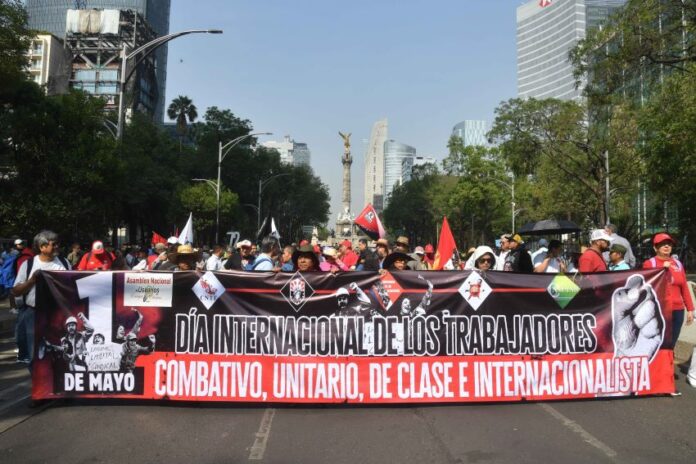Tens of thousands of workers took part in Labor Day demonstrations in Mexico City on Thursday, demanding a five-day workweek and access to better housing.
After gathering at designated sites across Mexico City as early as 7:30 a.m., marchers began arriving at the Zócalo shortly after 9 a.m.
Each union was announced and applauded as it strode into the main plaza. The atmosphere was described as “festive” by La Jornada newspaper, with several bands playing regional music on stages set up in front of the Cathedral.
Signs and speeches supported reducing the official workweek from 48 to 40 hours. Lawmakers were urged to support a bill that would mandate two days off each workweek. The legislation is currently bottled up in Congress.
Union leaders also called for better health care and an end to taxes on contractual benefits.
Union organizers and labor representatives then lunched with President Claudia Sheinbaum at the National Palace.
👨🏭 Integrantes de diversos sindicatos marchan hacia el Zócalo capitalino para exigir respeto a sus derechos laborales, en el marco del #DíaDelTrabajo.
📸#DíaEnImágenes / Yazmín Ortega Cortés pic.twitter.com/eiL7xrYmzo
— La Jornada (@lajornadaonline) May 1, 2025
Alternative demonstrations abounded. One group demanding a 40-hour work week broke off from the Zócalo demonstration and marched to the Monument to the Revolution for a second rally.
At the same time, a labor rights group marched from the Monument to the Revolution to the Palacio de Bellas Artes to show support for unionized workers whose demands have been dismissed by management.
Even the U.S.-based organization Democrats Abroad staged a protest for May Day, as the holiday is known in the U.S. The organization summoned participants to the U.S. Embassy in Mexico City in an act of resistance against U.S. President Donald Trump and the Republican Party’s efforts to establish “an authoritarian police state bent against the people of the United States and Mexico.”
Not all was peaceful, however. El Universal newspaper reported that police skirmished with masked demonstrators armed with bottles, metal pipes and Molotov cocktails. The vandals — calling themselves “Bloque Negro” (Black Alliance”) — caused damage to several shops in the Historic Center.
A tradition dating to 1913
International Workers’ Day, or Labor Day, is an official holiday in Mexico inscribed in the 1917 Constitution.
Whereas in the United States, Labor Day (celebrated on the first Monday in September) is largely seen as a long weekend for picnics, barbecues and the unofficial end of summer, in Mexico it features citywide marches, declarations of solidarity and speeches by union leaders and politicians.
In addition to stipulating May 1 as a federal holiday, Article 123 of the Constitution established the 8-hour workday, 6-day workweek, minimum wage, equal pay, and the right to organize, to collectively bargain, and to strike.
Over time, the May 1 commemoration has gained in significance in Mexico, becoming a day of reflection about labor conditions and social justice. It is also a day to celebrate the advances that have transformed Mexico’s labor environment.
Among the developments recognized are an end to child labor, improved labor safety conditions, a requirement to have Sundays off and improved workers’ compensation benefits.
The first public commemoration of Labor Day in Mexico took place on May 1, 1913, when the Casa de Obrero Mundial (House of the World Worker) union sponsored a march in which 25,000 workers participated.
International recognition of May 1 as Workers’ Day memorializes the violent repression of a labor protest in Chicago on May 1, 1886.
With reports from La Jornada, El Universal, El Economista, Excelsior and Milenio
